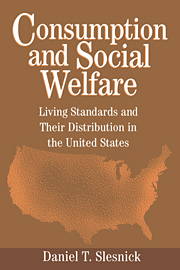Book contents
- Frontmatter
- Contents
- Acknowledgments
- 1 Introduction
- 2 The measurement of economic welfare
- 3 Measuring consumption: An initial look at the data
- 4 The cost of living
- 5 The standard of living
- 6 Does a rising tide raise all ships?
- 7 Consumption and poverty
- 8 Conclusions
- Appendix 1 Measuring individual and social welfare
- Appendix 2 Interpolating and extrapolating the expenditure distribution
- References
- Index
2 - The measurement of economic welfare
Published online by Cambridge University Press: 10 December 2009
- Frontmatter
- Contents
- Acknowledgments
- 1 Introduction
- 2 The measurement of economic welfare
- 3 Measuring consumption: An initial look at the data
- 4 The cost of living
- 5 The standard of living
- 6 Does a rising tide raise all ships?
- 7 Consumption and poverty
- 8 Conclusions
- Appendix 1 Measuring individual and social welfare
- Appendix 2 Interpolating and extrapolating the expenditure distribution
- References
- Index
Summary
INDIVIDUAL WELFARE
How should the standard of living be measured? Although welfare measurement is a fundamental element of economic analysis, it is also an undertaking fraught with peril. Well-being is influenced by a number of factors related not only to an individual's economic position but also to his or her social, political, physical, emotional, and psychological status. Measuring an inherently multidimensional concept by a single statistic almost certainly ignores relevant information.
The definition of welfare presented in this chapter is based exclusively on material well-being. This is obviously a narrow perspective, and there are compelling arguments for using information other than economic status. There are also many serious obstacles that have yet to be overcome. Rather than tackle these issues, I acknowledge at the outset that I am looking at only one of many possible dimensions of the standard of living. The development of a more comprehensive concept of individual and social welfare will be left for future investigation.
The key assumption of the traditional approach to welfare economics is that well-being is derived from the consumption of goods and services. The standard theoretical paradigm describes consumers as “rational” agents who choose the combination of goods that maximizes welfare (i.e., utility) subject to the constraint of limited financial resources. Well-being is a function of the quantities consumed so that, in this framework, it is at least theoretically possible to infer the level of welfare from the observed quantities of the goods consumed.
- Type
- Chapter
- Information
- Consumption and Social WelfareLiving Standards and their Distribution in the United States, pp. 8 - 41Publisher: Cambridge University PressPrint publication year: 2000



